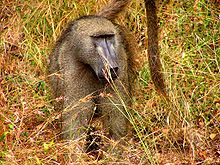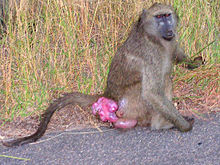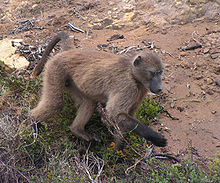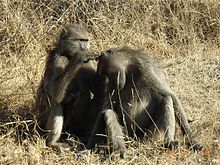- Chacma baboon
-
Chacma baboon[1] 
P. u. griseipes, male, Kruger Park, South Africa Conservation status Scientific classification Kingdom: Animalia Phylum: Chordata Class: Mammalia Order: Primates Family: Cercopithecidae Genus: Papio Species: P. ursinus Binomial name Papio ursinus
(Kerr, 1792)Subspecies 3 ssp., see text

Geographic range The Chacma baboon (Papio ursinus), also known as the Cape baboon, is, like all other baboons, from the Old World monkey family. With a body length of up to 115 cm and a weight from 15 to 31 kg, it is among the largest and heaviest baboon species. The Chacma is generally dark brown to gray in color, with a patch of rough hair on the nape of its neck. Unlike the northern baboon species (the Guinea, Hamadryas, and Olive baboons), Chacma males do not have a mane. Perhaps the most distinctive feature of this baboon is its long, downward sloping face.[3][4] Males can have canine teeth as long as 2 inches (longer than a lion's canine teeth). Baboons are sexually dimorphic, males being considerably larger than females.
Contents
Range
The Chacma baboon is found in southern Africa, ranging from South Africa north to Angola, Zambia, and Mozambique. Size and color vary within that range. The Cape Chacma (P. ursinus ursinus) from southern South Africa is a large, heavy, dark brown baboon with black feet. Another subspecies, the Gray-footed Chacma (P. u. griseipes), is present from northern South Africa to southern Zambia. It is slightly smaller than the Cape Chacma, lighter in color and build, and has gray feet. The Ruacana Chacma (P. u. ruacana) is found in Namibia and southern Angola, and generally appears to be a smaller, less darkly colored version of the Cape Chacma.
Behaviour
Chacmas usually live in social groups composed of multiple adult males, adult females, and their offspring. Occasionally, however, very small groups form that include only a single adult male and several adult females.[5] Chacma troops are characterized by a dominance hierarchy. Female ranking within the troop is inherited through the mother and remains quite fixed, while male ranking is often in flux, especially when the dominant male is replaced. Chacmas are unusual among baboons in that neither males nor females form strong relationships with members of the same sex. Instead, the strongest social bonds are often between unrelated adult males and females. Infanticide is also common compared to other baboons species, as newly dominant males will often attempt to kill young baboons sired by the previously dominant male.[6] Baboon troops possess a complex group behavior and communicate by means of body attitudes, facial expressions, vocalisations and touch.
Habitat
Chacmas inhabit a wide array of habitats, from the grassy alpine slopes of the Drakensberg to the Kalahari desert. The Chacma baboon is omnivorous with a preference for fruits, while also eating insects, seeds, grass and smaller vertebrate animals. The Chacma baboon is generally a scavenger when it comes to game meat and rarely engages in hunting large animals. There has been one incident where a Chacma baboon has killed a human infant, however the event is so rare the locals believed it was due to witchcraft.[7] Normally Chacma baboons will flee at the approach of humans. This has been changing due to the easy availability of food where there is interaction with humans.[8]
Status
The Chacma baboon is widespread and does not rank among threatened animal species. However, in some confined locations such as South Africa's Southern Cape Peninsula, local populations are dwindling due to habitat loss, as well as predation from other protected species, such as leopards and lions.[9] Some troops have become a suburban menace, overturning trash cans and entering houses in their search for food. These animals can be aggressive and dangerous, such negative encounters have resulted in frustrated local residents resorting to hunting them. It is thought that this isolated population will face extinction within 10 years.[8]
The Chacma is considered to be potentially threatened under C.I.T.E.S Appendix 2,[10] if populations are not monitored. The only area in South Africa where they are monitored is in the Cape Peninsula where they are protected.
 P. u. griseipes, female in estrus, Kruger Park, South Africa
P. u. griseipes, female in estrus, Kruger Park, South Africa
Observations by those working hands-on in South Africa's rehabilitation centres, have found that this species is damaged by human intervention; troop structures are influenced and over the years there has been a significant loss in numbers.[11] Because they live near human habitats, baboons are shot, poisoned, electrocuted, run over and captured for the pet industry, research laboratories and muthi (medicine).
Snaring primates and other species for bushmeat has become a growing problem around poverty stricken areas.
Subspecies
There are three subspecies of the Chacma baboon:[1][12]
- Papio ursinus ursinus Kerr, 1792 – Cape Chacma (found in southern South Africa)
- Papio ursinus griseipes Pocock, 1911 – Gray-footed Chacma (found in northern South Africa to southern Zambia)
- Papio ursinus raucana Shortridge, 1942 – Ruacana Chacma (found from Namibia to southern Angola)
In Popular Culture
In 2011, the British Television Channel ITV1 aired an eight episode mini-series, hosted by popular British comedian Bill Bailey, with exclusive features from the series on itvWILD. The series followed the lives of three different family groups of Chacma baboons in South Africa.[13] The series focuses on the baboons' abilities of adaptation to human settlement and their complex social-lives. It is generally structured within a narrative, with each adult baboon having a name and being treated as an 'actor' in the story. The three families of baboons have each developed their own ways of life, the 'Smitz' group spends most its time trying to rob food from tourists along a coastal highway, the 'Tokai' group has remained in a more natural forest area, while the 'Da Gama' group lives on the rooftops of an apartment complex. The program is the second attempt of Bailey to produce a semi-serious nature documentary and it has received good reviews.[14]
References
- ^ a b Groves, C. (2005). Wilson, D. E., & Reeder, D. M, eds. ed. Mammal Species of the World (3rd ed.). Baltimore: Johns Hopkins University Press. pp. 167. OCLC 62265494. ISBN 0-801-88221-4. http://www.bucknell.edu/msw3/browse.asp?id=12100588.
- ^ Hoffmann, M. & Hilton-Taylor, C. (2008). Papio ursinus. In: IUCN 2008. IUCN Red List of Threatened Species. Downloaded on 4 January 2009.
- ^ Jolly CJ (1993). WH Kimbel and LB Martins, eds.. ed. Species, Species Concepts, and Primate Evolution. New York: Plenum Press.
- ^ Groves C (2001). Primate Taxonomy. Washington DC: Smithsonian Institution Press.
- ^ Byrne RW, Whiten A, Henzi SP (1987). "One male groups and intertroop interactions of mountain baboons". International Journal of Primatology 8: 615–633. doi:10.1007/BF02735780.
- ^ Henzi P, Barrett L (2003). "Evolutionary ecology, sexual conflict, and behavioral differentiation among baboon populations". Evolutionary Anthropology 12: 217–230. doi:10.1002/evan.10121.
- ^ Dhlamini, Dan (2003-08-06). "Witchcraft, says baby's mom". http://www.news24.com/News24/South_Africa/News/0,6119,2-7-1442_1370720,00.html. Retrieved 2007-12-15.
- ^ a b Lorna Thomas (2006). "Working to Save South Africa's Chacma Baboons". http://www.gonomad.com/helps/0601/baboons.html. Retrieved 2007-02-19.
- ^ "Leopard and Lion predation upon Chacma baboons living in the Moremi Wildlife Reserve". http://www.curtbusse.com/pubs/Busse1980.html.
- ^ http://www.cites.org/eng/app/E-Jul01.pdf
- ^ http://www.asendletrust.org/?p=34
- ^ Chacma Baboon TrekNature
- ^ ITV1. "Baboons with Bill Bailey". itvWILD. ITV. http://www.itvwild.com/tvshows/baboons-with-bill-bailey. Retrieved 9. June 2011.
- ^ Hall, Jon (8. April 2011). "TV review: Baboons with Bill Bailey". Edinburgh Evening News. http://edinburghnews.scotsman.com/features/TV-review-Baboons-with-Bill.6748330.jp. Retrieved 09.06.2011.
External links
- Cape Peninsula Baboon Research Unit
- Darwin Primate Group
- Imfene Baboon Conservation and Education Centre
Categories:- IUCN Red List least concern species
- Mammals of Africa
- Fauna of Zambia
- Megafauna of Africa
- Cercopithecine monkeys
- Animals described in 1792
Wikimedia Foundation. 2010.



